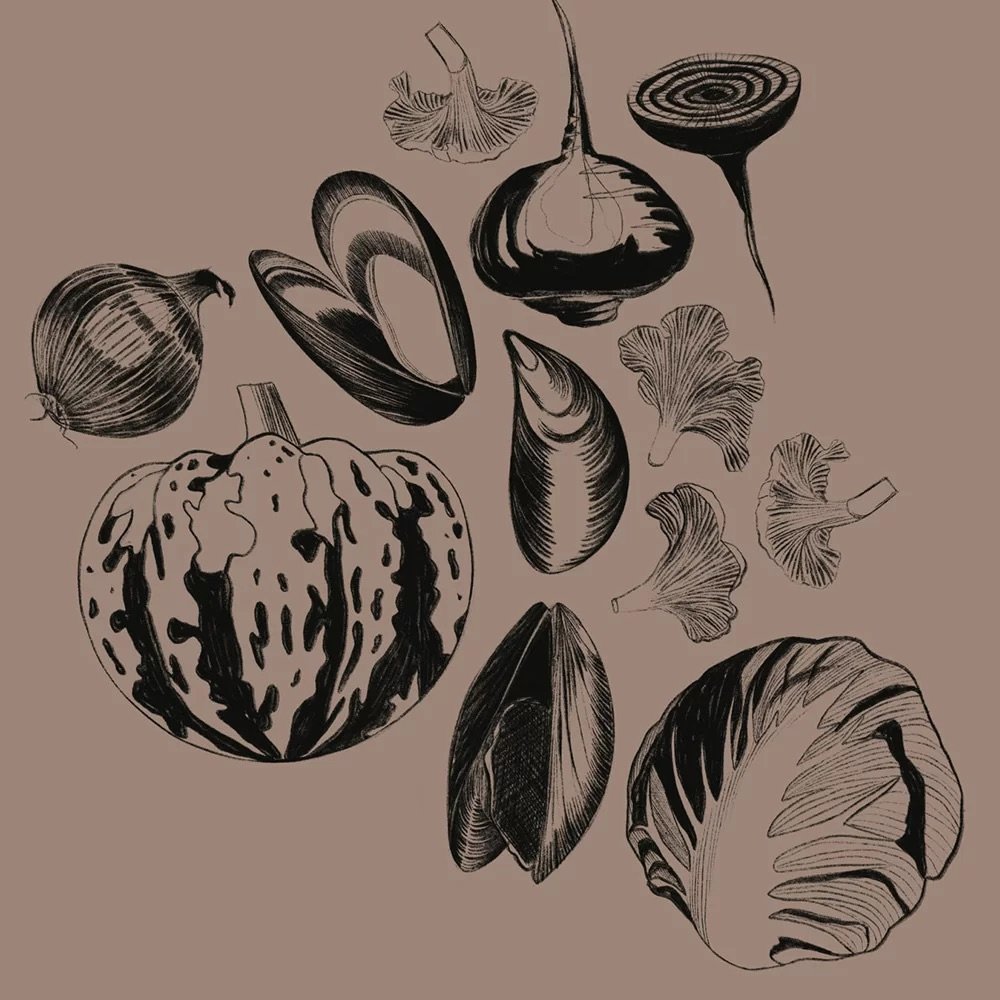WILDWOOD’S SIGNATURE PAN-ROASTED MUSSELS
Words and recipe by Cory Schreiber. Illustration by Kate Blairstone.
Medley of ingredients illustration by Kate Blairstone.
THE BLESSING AND CURSE OF THE SIGNATURE DISH
WHEN A CHEF OPENS A RESTAURANT AND DEVELOPS A “SIGNATURE” MENU ITEM, THAT DISH CAN BE A BLESSING AND, SOMETIMES, A CURSE. Signature dishes are menu items that can become symbolic and are used by the public and/or media to describe the restaurant’s style of food and cooking. When I opened WILDWOOD RESTAURANT AND BAR, I put a mussel dish on the menu with red wine, heavy cream, black pepper, and thyme. The sauté station was in charge of preparing that item, and it sold well. So well, in fact, that it made it difficult for the sauté cook to put out the other dishes from the station at the same rate as the rest of the cooks were preparing their menu items. The popularity of these mussels bogged down not only the sauté cook but the speed with which other menu items were delivered to the dining room.
I quickly moved the mussel dish to the wood oven, where it cooked in half the time, and revised the recipe by adding tomatoes, saffron, garlic, olive oil, and white wine vinegar. It was an instant success and the dish remained on the menu for 20 years. It wasn’t a calculated decision to make these mussels a signature dish—signature dishes aren’t always planned or anticipated. The new preparation was inspired by classic Mediterranean flavors frequently paired with seafood, that could be prepared in a wood-fired oven. Given the restaurant’s name, Wildwood, it made sense to showcase a dish from the wood oven. We used sun-dried tomatoes in the winter months, allowing the mussel dish to remain on the menu throughout the calendar year. (A signature item must be available consistently.)
PUTTING IT ALL TOGETHER
BEFORE YOU PURCHASE THE MUSSELS, and put it all together, ask your fishmonger when they were harvested. If they have been out of the water for more than 3 days, submerge them in lightly salted water for 5-8 minutes to rehydrate them before cooking, and add more liquid to the sauce. Remove the “beard” before cooking and, if any remains, after cooking, before serving.
Makes four appetizer-sized servings.
Recipe reprinted with permission from Wildwood: Cooking from the Source in the Pacific Northwest, by Cory Schreiber. Artwork by Kate Blairstone, based on her full-color cover illustration for KITCHEN TABLE #1.
INGREDIENTS
3 lbs mussels
1 cup cherry tomatoes, halved, or ½ cup sun-dried tomatoes, coarsely chopped
2 shallots, thinly sliced
1 Tbsp minced garlic
Saffron vinaigrette (see recipe below)
2 Tbsp fresh lemon juice
½ cup chopped fresh flat-leaf parsley
Four ½-inch thick slices hard crusted bread, toasted and rubbed with garlic cloves and olive oil if desired.
PROCEDURE
Put the mussels in a large skillet over medium heat. Add the tomatoes, shallots, and garlic, then pour the vinaigrette over the mussel mixture. Cover skillet and cook for 5-6 minutes.
Uncover the skillet and continue to cook the mussels until they open, transferring them as they open to a covered container to keep warm. If the mussels do not open, you can attempt to pry them open using a butter knife and wiggling the shells apart between the openings. If you encounter one that smells off, then discard it.
When all the mussels have opened, add back to the skillet, then drizzle the lemon juice into the vinaigrette and cook for an additional 30 seconds. Stir in the parsley.
Divide the mussels among four bowls and pour the remaining vinaigrette from the pan over them. Serve with the toasted bread.
SAFFRON VINAIGRETTE
(make ahead)
½ cup Chardonnay vinegar or other white wine vinegar
6-7 saffron threads
1/3 cup extra virgin olive oil
1/3 cup vegetable or safflower oil
Salt and freshly ground black pepper
In a medium nonreactive saucepan, combine the vinegar and saffron threads. Bring to a simmer over medium heat. Remove from heat and let cool. Whisk in the oils, salt and pepper; set aside.

